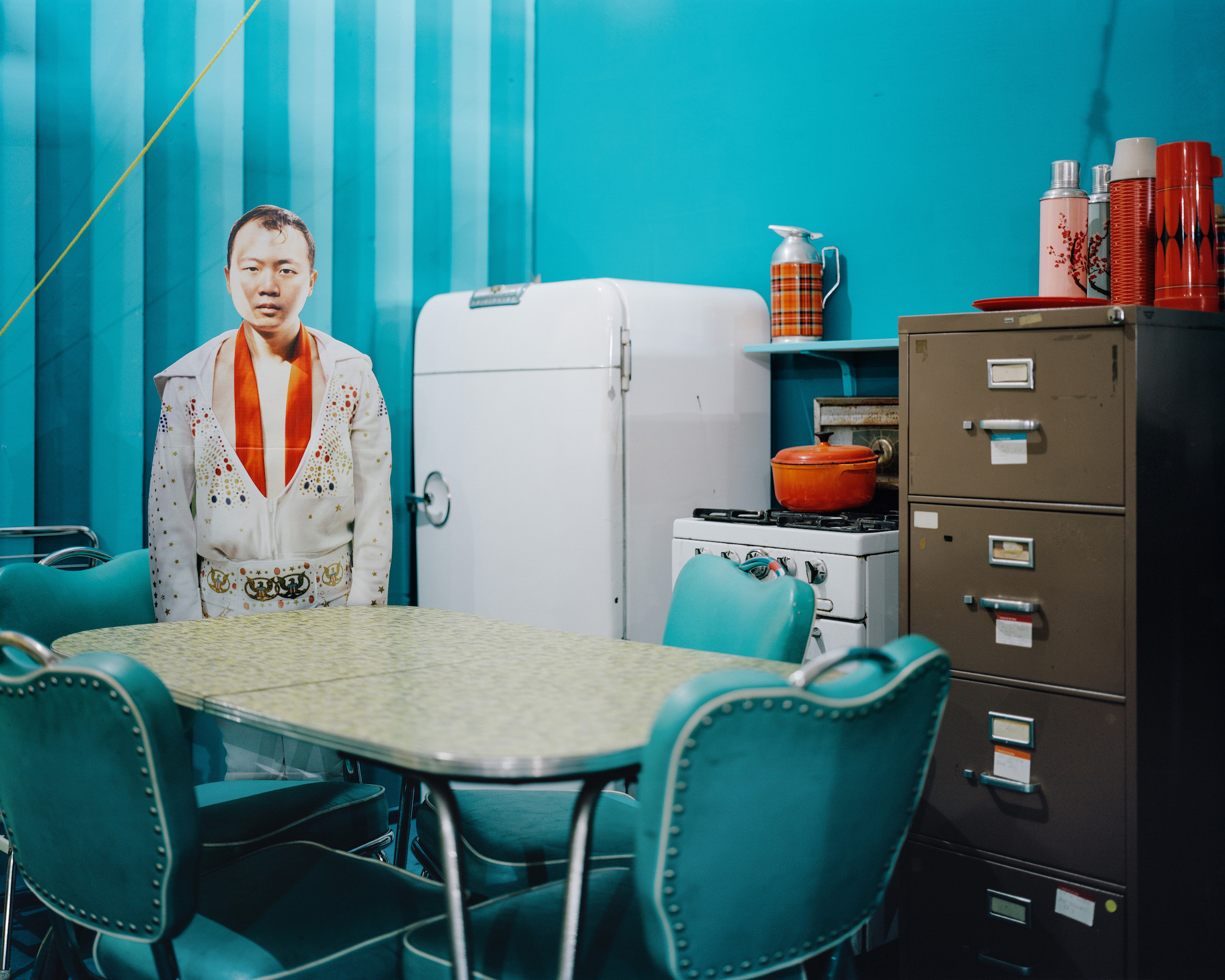All images © Tommy Kha
The artist makes wry commentaries on the immigrant experience using scattered visual fragments, from the depths of Tennessee’s Chinatown to the fishing communities of rural Vietnam. A new book and exhibition prove there’s method to the melange
Spend a little time in Chinatown – any Chinatown, in any city, in any country in the world – and sooner rather than later, you’ll encounter a shrine. Perhaps you’ll notice it at the entrance to a store: a wooden altar leaning up against an ATM, guarded by a golden lucky Buddha, whose smile and big belly invites prosperity and fortune. Or maybe somewhere easier to miss, like tucked in an alcove behind the cash register, where a figure of Guan Yin provides peace and protection.
There’s a shorthand to the visual language of these shrines: round brass censers filled with sand and incense ash; tiny cups of rice wine and plates of shiny, thin-skinned tangerines, placed as offerings. Red abounds, in the lacquered wood, lucky papers, and burnt magenta bases of joss sticks. For immigrants and their children, these shrines aren’t merely religious artefacts. They are anchors, stations, concrete evidence of the longevity of cultural tradition, demarcating the geographic space where the diaspora has been borne.
Photographs of such shrines encircle the walls of Ghost Bites, Tommy Kha’s show at Baxter St, the exhibition space of the Camera Club of New York. The prints are small – just four by five inches – and are hung in a row, forming a literal throughline of the show, interposed between larger framed prints and vinyls.
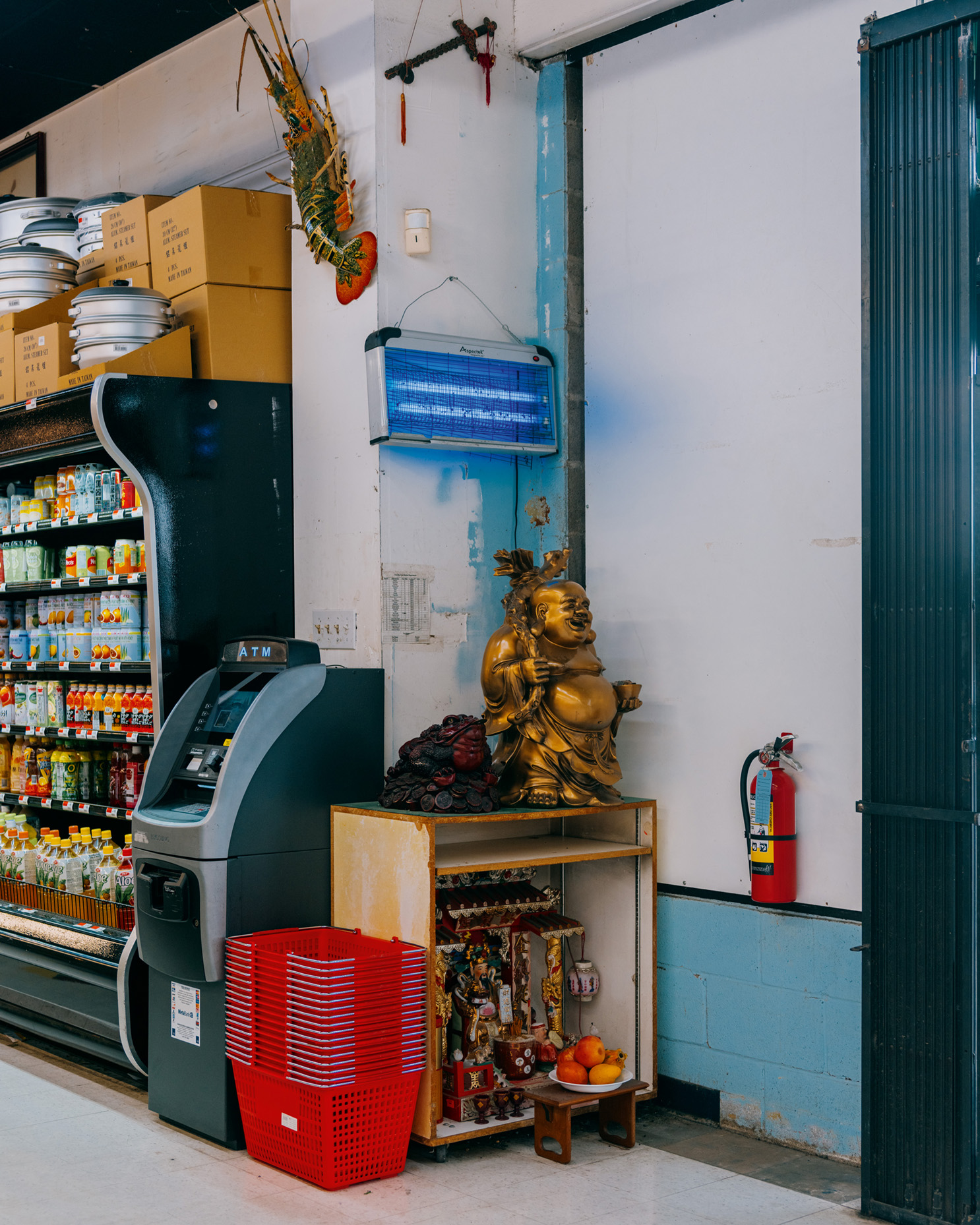
Collected in Manhattan’s Chinatown and in Kha’s hometown of Memphis, Tennessee, at first glance one shrine seems much like another, and each like any other shrine I’ve seen before, but it’s that half-familiarity that makes the photos engaging. I double-take. Have I walked past this one before? I think I recognise this business, that metal grate, that specific corner. Some of the images feel uncannily close, so close I can practically smell the incense burning and see the sepia circle it stains on the ceiling. Could this be my aunt’s monument to the kitchen god, my grandmother’s household altar? Of course neither are, but what holds my attention is the possibility that they might be. The rituals toward which the shrines gesture are as displaced as they are familiar.
This mix of familiarity and displacement – or, sometimes, estrangement – is a key element of Kha’s work. In Tree (Grandma Sleeping), a large portrait from 2019, Kha’s grandmother sleeps on her side, a wrinkle in her brow. Surrounding her are markers of an ambiguously pan-Asian household: a plush, patterned fleece blanket, pastel floral sheets, Chinese red paper decorations above the light switch – details instantly recognisable to any child of immigrants. On the wall are four lacquer and mother-of-pearl panels, arranged like music notes moving down a stave.
The panels depict bucolic scenes of Vietnamese country life: a fisherman reeling in a catch; farmers stooping to gather rice in a paddy. Yet the image resists the usual narratives of family portraiture. Those seeking a nostalgic connection to their own elders will be thwarted by Kha’s grandmother’s frown, which is neither long-suffering nor saintly. Her sleeping form, self-contained, rejects interpretation and by extension, sentimentality. And those hoping for some kind of earthy authenticity, some enriching flavour from the motherland, are met instead with flat graphic imagery which reflects our canned ideas of Asian-ness back to us. I wonder where I’m supposed to look – until I realise the picture is also an image of Kha looking, meeting his grandmother on her terms in the home that she has made, parsing her face for glimpses of himself in her story. He’s placed us in his position, invited us to see the world as he sees.
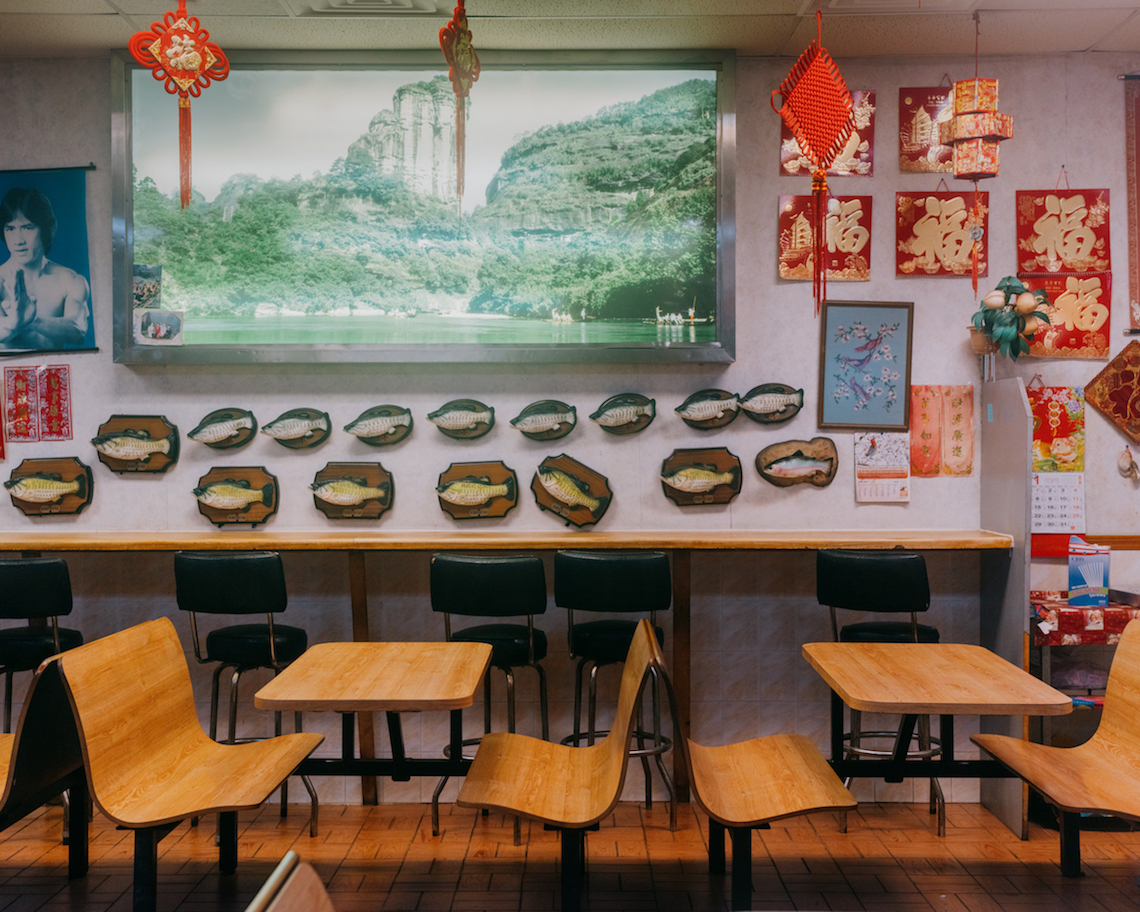
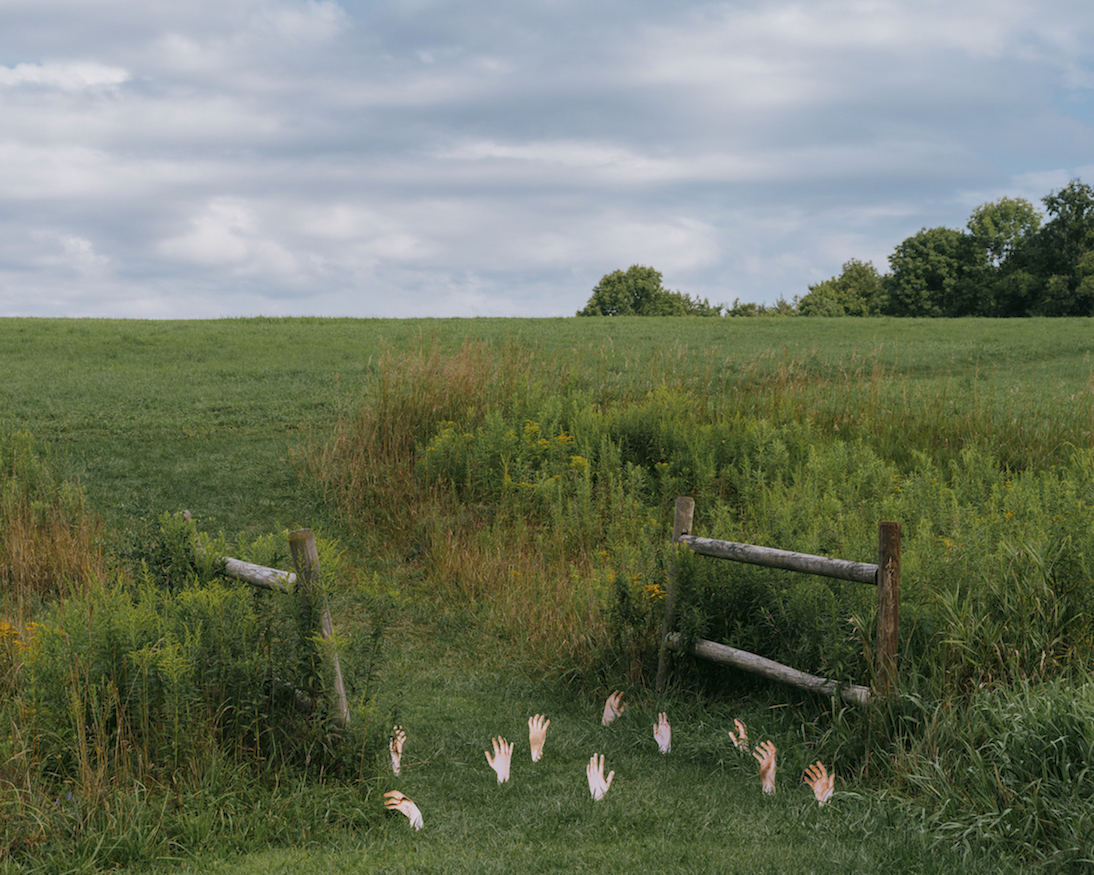
Immigrant Ghosts
Ghost Bites refers to the Vietnamese term ma cắn, or the bruises and scratches that appear without explanation. What makes marks on us, shapes us without our noticing? For children of immigrants, our lives are moulded by events that have occurred long before our births, the displacing effects of colonialism, war and poverty. “Fleeing countries is a family trait,” Kha says in an interview with fellow photographer An-My Lê, included in Half, Full, Quarter. The artist’s grandparents left China for Vietnam in the 1930s. His mother was born in Saigon, and fled the country in 1983, her mother eventually joining her, where they settled in Memphis. By the time Kha was born in 1988, a history had already formed, accumulated, and made its mark.
Kha sees his own practice through the lens of his forebears, in particular a series of photographs his mother took in Ontario in 1984, many of which appear in the book, and are reproduced as small scale vinyls in Ghost Bites. But where his mother’s snapshots are acts of documentation, commemorating birthdays and holidays, Kha’s images are performative, even staged. Each picture seems to have a surprising tail to it – a quirk or flourish that turns its story on its side. Being an immigrant, Kha suggests, is both more funny and more strange than we expect.
Children of immigrants often turn to received narratives to tell us about who we are and how we should live. For the Asian diaspora, especially in the US, the visual aspect of these narratives can feel like a strange slurry, a funhouse mirror of pan-Asian Orientalism and kitschy pastiche. Stripped of cultural specificity – at least by a largely white mainstream America – Asian-ness becomes an uncodified blob, like the “Asian” section at a grocery store. And yet there’s some kind of solace, a shared affection in precisely that melange. Sure, a costume is a costume, tweaked to accommodate American ingredients and tastes, but when repeated enough times, it becomes its own kind of culture – a novel aesthetic of the Asian immigrant, born out of adaptation.
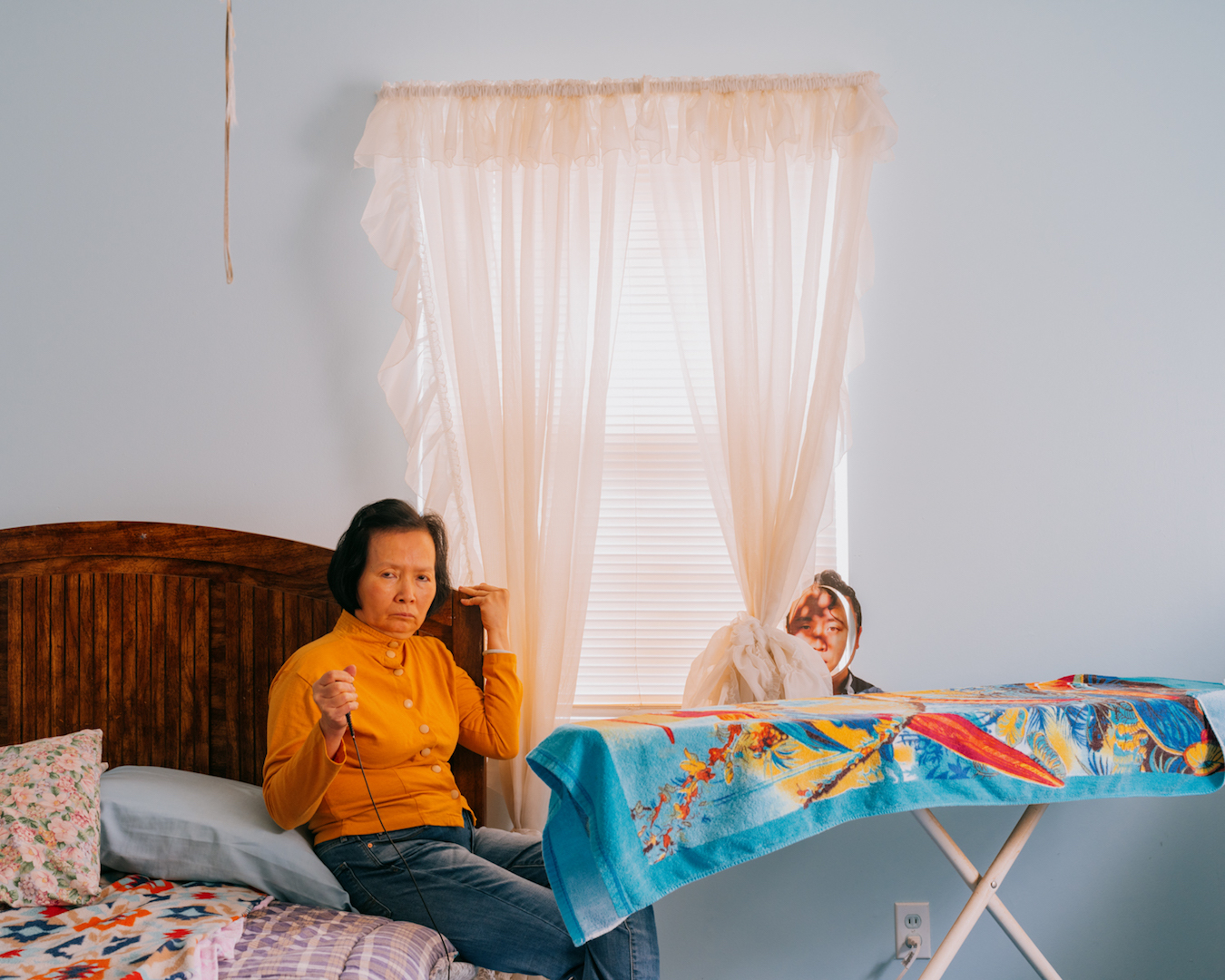
“Stripped of cultural specificity – at least by a largely white mainstream America – Asian-ness becomes an uncodified blob, like the ‘Asian’ section at a grocery store”
Two photographs in Ghost Bites evoke this layered mishmash of representation. The first is a closeup of a mural, featuring a trio of women in ambiguously traditional Vietnamese clothing standing in front of a pagoda that rises from the middle of a pond. The second photograph reveals the mural’s location on the side of Lotus Family Style, a restaurant that advertises both “Authentic Asian Cooking” and “Steaks and Bar-B-Que” as specialties. The painting is obviously very bad, so bad it bypasses being Orientalising and becomes kitschy and endearing once more. It offers a kind of performance, an idea of what we think Americans think they want when they think of us.
The humour turns practically slapstick when juxtaposed with a third image on the wall, New China (New Lin’s Chinese). It shows the interior of a different Chinese restaurant, baroque in its Asian Americana, featuring not only a Bruce Lee poster, red decorations, and a backlit photograph of South Chinese karst mountains, but also no less than sixteen Big Mouth Billy Bass wall-mounted singing fish plaques, which are not culturally Chinese in the slightest but very funny when placed in a restaurant. They’re weird. They’re funny. They’re not supposed to be there, but who is supposed to be anywhere?
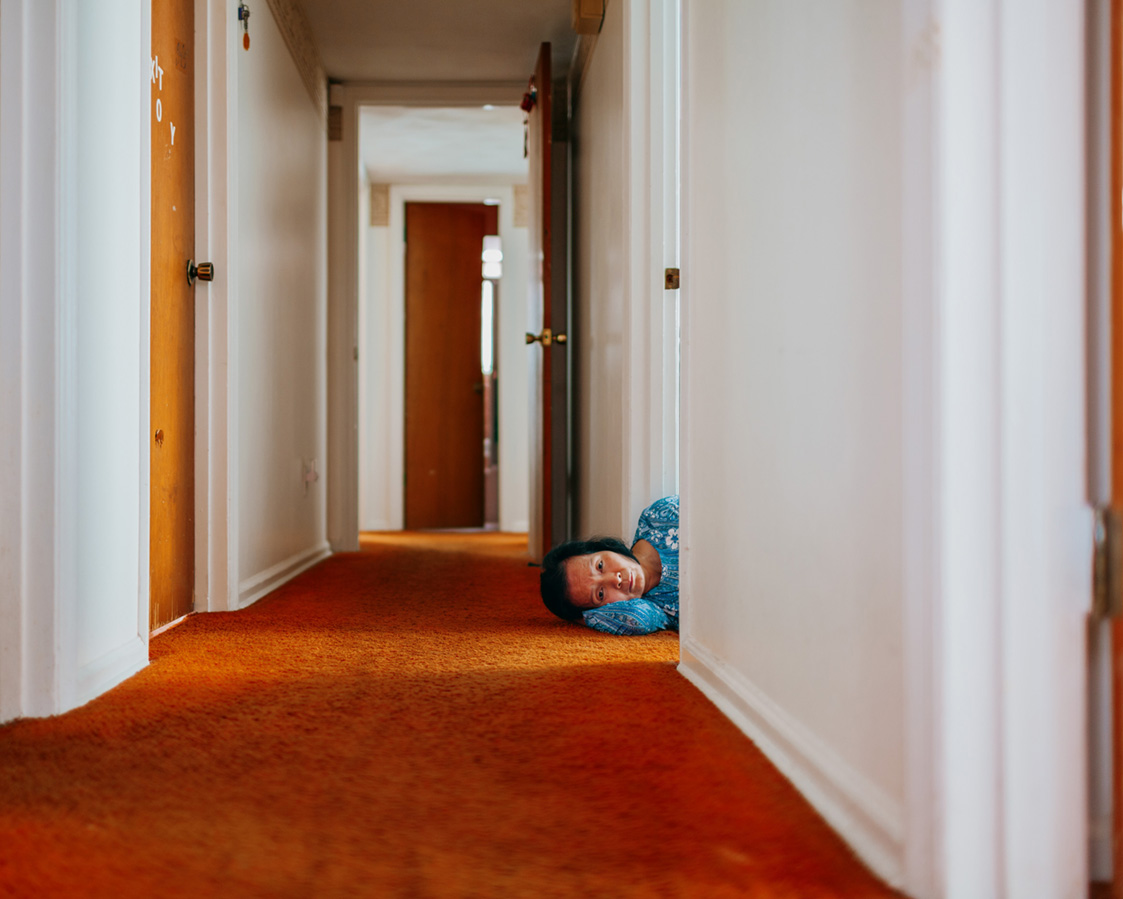
Behind the Mask
Half, Full, Quarter comes with a round paper cutout of Kha’s face, his expression deadpan. Tucked into my copy for safekeeping, it slips out at odd times, prompting the thought: “He’s not supposed to be here.” Which is also a refrain of Kha’s, a shorthand for the dislocated immigrant’s experience. In their interview, An-My Lê makes reference to “Tommy’s world,” as much a mode of play as it is a way of seeing.
In one series of images, friends pose with a cutout of Kha’s face. In another portrait, Kha’s mother sits on the floor next to the dental chair Kha’s father used while covertly practising as a dentist from their home. Kha’s cardboard face can be seen beneath the tan armrest, reddened as if from the effort of hiding – but then we see Kha’s real face, or at least the top of it, peering out from behind the chair, one kiss-curl casting a shadow on his forehead. Again, he’s not supposed to be there – or there.
Masks are a way for Kha to be both present and absent. The materiality of the paper printout, the crumpled-in face of a three-dimensional mask, and the floppy backing attached to a cardboard cutout, all speak to the constructed nature of identity and the self. That Kha shows us how his work is made hints at his attitude toward the idea of a persona: better to be vulnerable, to reveal the seams, clumsy as they are. We see the black cable of the camera’s remote. Yes, we know Kha is engaged in the making of a photograph. Yes, aren’t we all performing – creating ourselves – in some way, too?
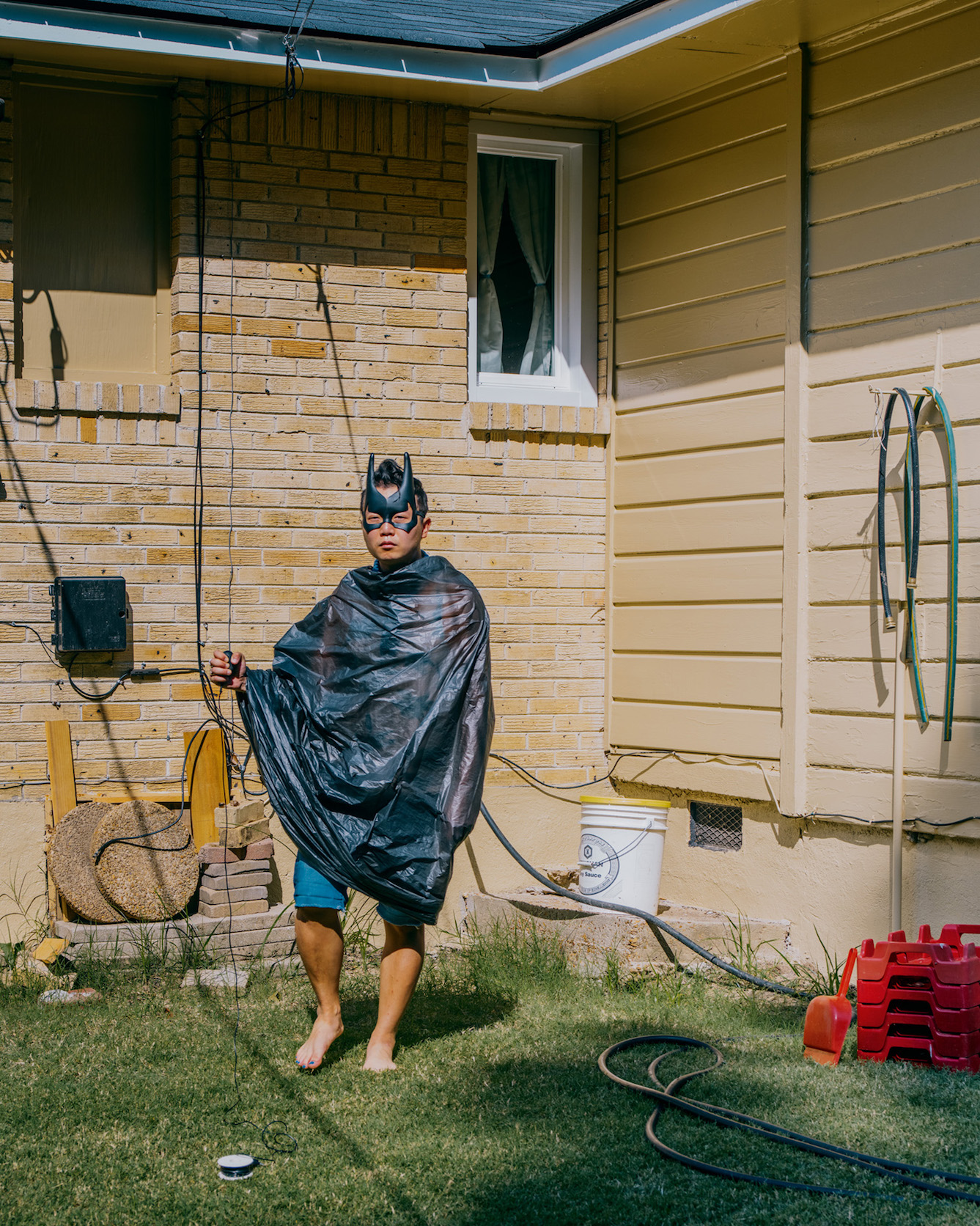
Kha is engaged in crafting a diasporic identity apart – though not distant – from cultural identity in a country where authenticity is no longer possible, or perhaps even desired. And isn’t the expectation of authenticity an American invention? Kha’s depictions of the Asian immigrant presence in the topography and landscape of Memphis highlight the resilience of a community that has found a way to endure, despite repeated displacement. Looking again at the shrines, I remember that our mundane rituals aren’t just ways of marking time. They’re the short acts of our lives, and in enacting them, we write our own histories.
In Ghost Bites, Kha moves beyond the form of the print. Vinyls bend around corners; one framed print is folded in on itself, like an open book. I was especially moved by a printed fabric piece in which Kha has collected a mix of paper cutouts and 3D paper replicas, of the kind ritually burned as offerings to ancestors. There’s durians, scallions, a hotpot setup and a stack of nesting ceramic bowls; sliced lemons on a cutting board, a horseshoe crab, and a mahjong set, among yet more paper ephemera. Some of the objects appear as if from above, others from the side, paper cutouts laid flat.
Everything is neatly arranged onto newspaper – the way Kha’s family used to have their meals – laid on the floor, and photographed. It’s the resulting print, pasted on a fleece-like fabric, that is displayed on the gallery floor. It’s a picture of pictures, arranged next to pictures – the skewed materiality of the paper cutouts and the inconsistent perspective confusing what’s real and what isn’t. I stand over it for a while, trying to catalogue, trying to distinguish what’s paper, and what kind of paper. That’s the trick, though, the riddle and its answer. Everything is real, or nothing is.
Tommy Kha, Half, Full, Quarter is out now (Aperture)
Tommy Kha, Ghost Bites is at Baxter St, CCNY, New York, until 22 March

